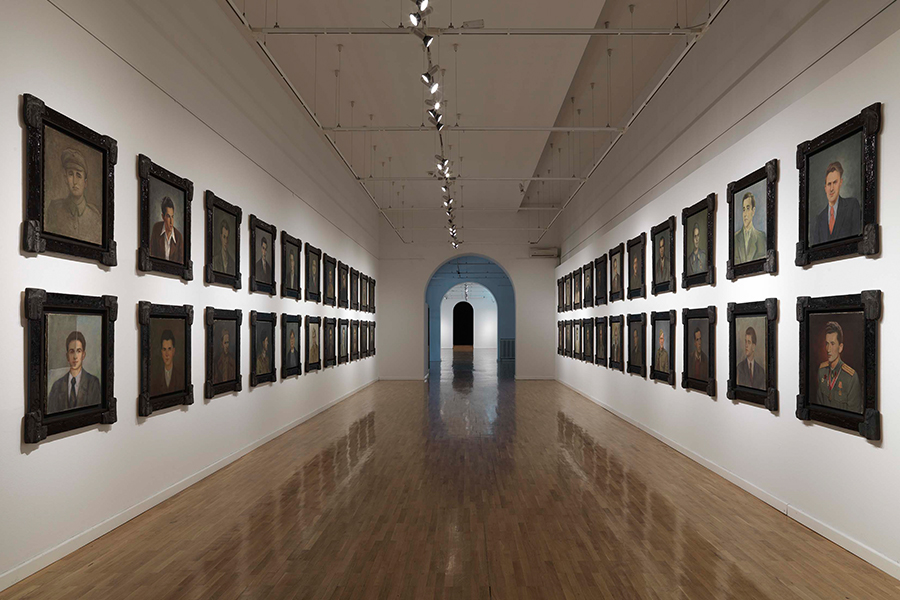With the exhibition Was ist Kunst Bosnia and Herzegovina / Heroes 1941–1941, the Museum of Contemporary Art of Republika Srpska presents one of the most intriguing artistic collectives of Eastern Europe, the Slovenian artistic group Irwin.
The project Was ist Kunst Bosnia and Herzegovina / Heroes 1941–1941 is realized in collaboration with the Historical Museum of Bosnia and Herzegovina.
Members of the group Irwin had chosen portraits of people's heroes, fighters from the People's Liberation Struggle period, which have been stored for almost 80 years in storage facilities of the Historical Museum of Bosnia and Herzegovina in Sarajevo and which were painted by the most prominent Bosnian- Herzegovinian artists from the period of socialist realism, in the years between 1948 and 1953. All of the portraits were painted with one goal, and that is the preservation of the cult of rememberance related to people's heroes.
In their characteristic manner, the group Irwin uses already existing portraits which they incorporate into massive frames that were specifically made for each portrait and by doing that, they will give these works, which are part of a project specifically designed for Banjaluka, a new meaning that will open possibilities for a new kind of interpretation and observation of the heritage from the Socialist era.
Taking the works which had already been created, with the characteristic use of the retroprincip methodology, which the group Irwin is recognizable for, resulted in the production of one of the most challenging exhibitions ever realized in the Museum of Contemporary Art of Republika Srpska, and all of this with the aim to give an adequate answer to the question Was ist Kunst Bosnia and Herzegovina, by observing and reading the exhibition.
Irwin
The story of the Slovenian artists’ collective starts in 1983 with the spontaneous collaboration between young artists from the punk and graffiti scenes in Ljubljana: Dušan Mandič, Miran Mohar, Andrej Savski, Roman Uranjek and Borut Vogelnik came together to found the group Rrose Irwin Sélavy, named in honour of the female pseudonym of Marcel Duchamp. In 1984, in collaboration with the music group Laibach and the Gledališče sester Scipion Nasice theatre company, they founded a broader artists’ collective, known as Neue Slowenische Kunst (NSK, i.e. New Slovenian Art), which was later to draw in other artists’ collectives ranging from graphics and video art to philosophy and in 1992 Neue Slowenische Kunst was turned into the NSK State in Time.
For Irwin, symbols may take on different meanings and connotations in different places and moments through an analysis of their origins. Their work, distinguished by their sharp wit and a pronounced sense of ambiguity, expresses a complex and subtle connection between art and ideology.
Irwin has taken part in projects presented at Manifesta 9 in Genk (2012) and the 50th Venice Biennale (2003) and many others exhibitions such as: Hans in Luck - Art and Capital, Lehmbruck Museum, Duisburg (2014); Former West, HKW, Berlin (2013); A Bigger Splash, Tate Modern, London (2012-13); NSK Passport Office, MoMA Museum of Modern Art, New York (2012); The Global Contemporary. The Art Worlds after 1989, ZKM Center for Art and Media, Karlsruhe (2011-12); The International, MACBA, Barcelona (2011); The Promises of the Past, Centre Pompidou, Paris (2010); State in Time, Kunsthalle Krems (2009); Here Is Every, MoMA Museum of Modern Art, New York (2008–09); NSK Passport Holders, Taipei Biennial, Taipei Art Museum (2008); Birds of a Feather, Akbank Art Center, Istanbul (2006–07); Collective Creativity, Kunsthalle Fridericianum, Kassel (2005); IRWIN: Retroprincip 1983–2003, Künstlerhaus Bethanien, Berlin (2003).
The members of the group live and work in Ljubljana.

